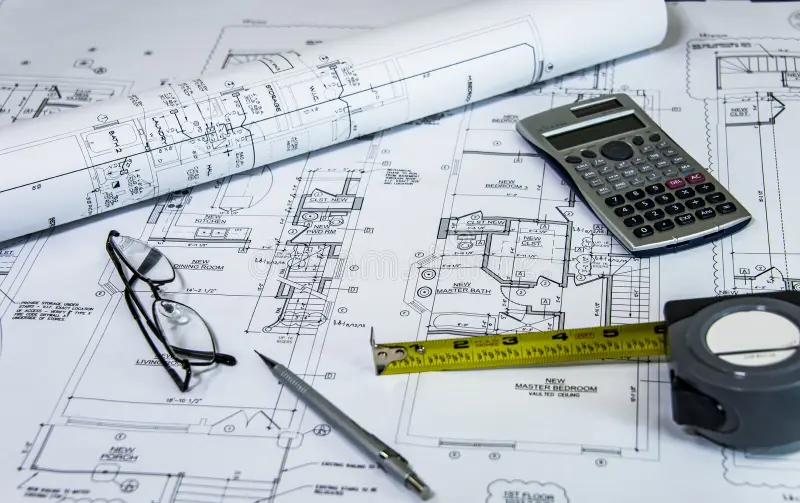Introduction to Construction Cost Estimating
When it comes to building, whether it’s a home, office, or infrastructure project throughout the US, one thing is clear—cost matters. Cost estimating is the heartbeat of construction planning. You’re leading the project in the dark if you don’t have precise projections. Let’s examine why construction estimating is such an important tool and how it can help you avoid financial trouble with your project.

To put it simply, cost estimating is the process of determining the total cost of a construction project before any work is done. Everything is covered, including supplies, labour, machinery, licenses, and more. It’s not just maths; it’s also a combination of art and science, and it’s absolutely necessary for the project to succeed.
Why It Matters in Today’s Market
Since labour and material costs are constantly increasing in the USA, a mistake could cost thousands or even millions of dollars. Owners are reassured by accurate cost estimates, which also help contractors win bids and guarantee reasonable financing.
Types of Construction Cost Estimates
Preliminary Estimates
These approximate numbers are utilised in the early stages of planning. They aren’t very detailed, but they aid in determining viability.
Detailed Estimates
These are thorough and dissect each component of cost. Budgeting and bidding are done with this type.
Quantity Takeoff
This entails enumerating all necessary supplies and materials, along with precise amounts. It is the foundation of a sound estimate.
Bid Estimates
These are used by contractors to provide project owners with their prices. They take profit margins and actual costs into account.
Key Components Of A Construction Estimate
Labor Costs
This includes wages, taxes, insurance, and benefits. Labor can vary by location and skill level.
Material Costs
Think concrete, wood, steel, and finishes. Market rates, availability, and delivery charges all factor in.
Equipment Costs
This could be anything from cranes to bulldozers. Whether you rent or own, the cost must be factored in.
Overhead and Profit Margins
Contractors have businesses to run. Office rent, software, salaries—these indirect costs matter too.
Contingency Allowances
No plan is perfect. Contingencies help cover the unknowns—like weather delays or price hikes.
The Estimating Process Step-by-Step
Project Scope Analysis
Understand exactly what’s being built. No surprises. Clear scopes reduce risks.
Gathering Cost Data
Pull in current prices from suppliers, subcontractors, and past projects.
Using Estimating Software Tools
Software makes it faster, more consistent, and reduces human error.
Reviewing and Validating the Estimate
Have a second pair of eyes check everything. Accuracy is everything.
Common Estimating Methods
Unit Cost Estimating
This involves multiplying the cost per unit (e.g., square foot) by the number of units.
Assembly Estimating
Costs are grouped by components or assemblies, such as a complete bathroom set.
Parametric Estimating
Uses statistical models based on historical data. Great for early-stage budgeting.
Accuracy Levels in Estimating
Class 1 to Class 5 Estimates
- Class 5: Feasibility studies (0-2% design complete)
- Class 1: Final estimate (up to 100% design complete)
How Accuracy Evolves with Design Development
As the design gets clearer, so does the estimate. Early estimates are rough; later ones are precise.
How Accurate Estimates Impact the Budget
Avoiding Overruns and Delays
Good estimates mean fewer surprises. You plan better and react faster.
Improving Bid Competitiveness
A tight, accurate bid wins more work—without losing profit.
Supporting Better Project Planning
From cash flow forecasting to materials ordering, estimates keep everything in sync.
Tools and Software for Better Estimating
Popular Estimating Software
- PlanSwift
- ProEst
- Buildertrend
- Bluebeam
Benefits of Digital Estimating
Speed, accuracy, cloud access, and collaboration. Plus, instant updates when prices change.
Challenges in Cost Estimating
Market Price Fluctuations
Prices can change overnight. Estimators must stay alert.
Incomplete Design Documents
Missing details? Your guess is as good as anyone’s.
Labor Shortages and Regional Differences
Wages and productivity vary—especially across states or countries.
The Role of Estimators
Who Are Construction Estimators?
They’re professionals trained to break down drawings into dollars.
Skills Needed for Accurate Estimating
- Math and analytical skills
- Construction knowledge
- Software proficiency
- Attention to detail
Real-World Example: Estimating Gone Right
A commercial contractor used detailed estimates and weekly market updates for a hospital build. Not only did they stay under budget—they finished ahead of schedule. Why? Because their cost projections guided every decision from day one.
Best Practices for Accurate Estimating
Regular Market Analysis
Check prices regularly. Don’t rely on outdated data.
Detailed Scope Documentation
The clearer your scope, the more accurate your numbers.
Third-Party Reviews
Another estimator or consultant can catch what you miss.
How All Bids Estimates Can Help
Expert Estimators
Our team knows construction and the numbers that drive it.
Accurate and Fast Estimates
All Bids Estimates use advanced software and up-to-date data for precision.
Helping You Stay on Budget
With our help, you’ll avoid guesswork and build with confidence.
Conclusion
Estimating construction costs is the cornerstone of a successful project and goes beyond simple maths. Accurate projections are crucial whether you’re a property owner trying to stay within your budget or a contractor bidding on a job. Do you want to save money, build more efficiently, and finish on schedule? Make a good estimate first.
FAQs
Q1: What’s the most accurate type of estimate?
A: A Class 1 detailed estimate based on final construction documents is the most accurate.
Q2: How can I reduce the risk of cost overruns?
A: Use updated cost data, review your scope, include contingencies, and always validate your estimates.
Q3: Is cost estimating the same for residential and commercial construction?
A: The core principles are similar, but scale, complexity, and code requirements differ.
Q4: How often should cost estimates be updated?
A: For large or long-term projects, update estimates every 30 to 60 days or when major changes occur.
Q5: What if the actual costs exceed the estimate?
A: Use your contingency budget first. Then review scope, negotiate with vendors, or adjust the project plan.
